25 Common SHORE BIRDS in Florida (ID Guide With Photos)
Did you recently spot a bird on the beach in Florida? In that case you’ll probably want to know what species you saw.
Identifying shorebirds of Florida is not as easy as you might think, since there are 25 different types of birds that frequent the beaches and seaboards of the sunshine state.
To help you identify the bird you saw, we’ll cover the common types of shorebirds that can be seen in Florida.
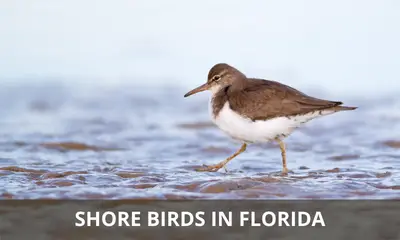
What are the types of shore birds in Florida?
The 25 types of shore birds that can be seen in Florida are:
- Sanderling
- Short-billed Dowitcher
- Black-bellied Plover
- Black-necked Stilt
- Spotted Sandpiper
- Willet
- Long-billed Dowitcher
- American Oystercatcher
- Great Egret
- Snowy Egret
- Little Blue Heron
- Great Blue Heron
- White Ibis
- Laughing Gull
- Ring-billed Gull
- Forster’s Tern
- Caspian Tern
- Roseate Spoonbill
- American Flamingo
- Double-crested Cormorant
- Royal Tern
- Herring Gull
- Tricolored Heron
- Black Skimmer
- Brown Pelican
While many of these birds are year round residents of Florida, others only occur in the state during the winter, as migratory birds that spend the cold months in the sunshine state.
Yet other birds are summer visitors during the breeding season, and some are scarce vagrants that are rarely seen in the state (more on that below).
Now let’s dive into the details, and take a closer look at each of these species in order to get the full scoop:
Sanderling
Scientific name: Calidris alba
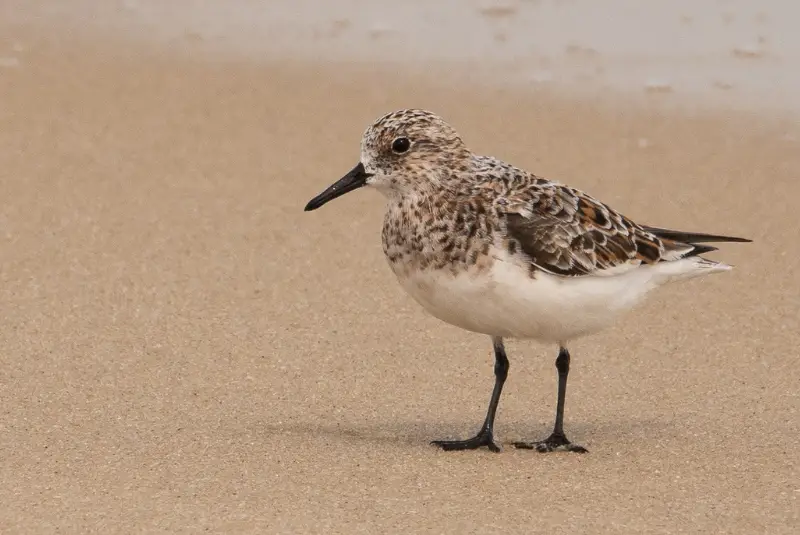
The Sanderling is one of the most common beach birds in Florida during the cold months, where it can be seen wintering from late August to April.
During the winter the plumage of Sanderlings is mostly white, and at this time of the year it is the lightest small wading bird on the beach.
The white stripe on its wings is only seen when it takes to the air.
Sanderlings like to forage in small groups on beaches, and run along the beach with surprising speed. They feed on small animals that are exposed by the breaking waves.
Another great characteristic for identification of Sanderlings are the white wing stripes, which flash brightly when it flies.
Short-billed Dowitcher
Scientific name: Limnodromus griseus
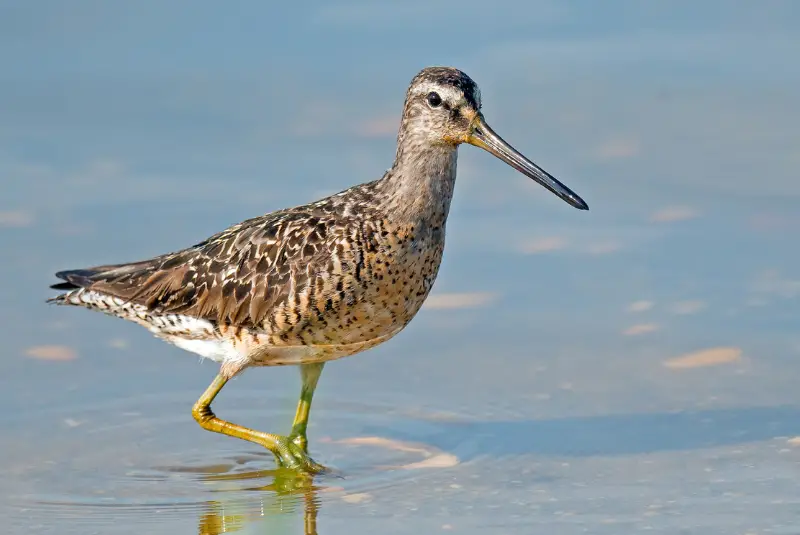
The Short-billed Dowitcher is a medium sized wading bird that is relatively easy to identify by its long, straight, dark bill.
It is a common year-round resident along the Florida Gulf Coast, but is also found in freshwater habitats.
During the winter it has a brownish-gray upperside, and white underside. During the breeding season, the throat and chest turn cinnamon orange.
This shore bird uses its long bill to probe for small invertebrates in muddy and sandy areas.
Long-billed Dowitcher
Scientific name: Limnodromus scolopaceus

The Long-billed Dowitcher is very similar to the Short-billed Dowitcher, and the two species are sometimes observed together.
However, while the Short-billed Dowitcher is a breeding bird in Florida, the Long-billed Dowitcher breeds in the arctic Tundra, and is seen in the state only during the winter.
While it’s hard to distinguish between the two species, the Long-billed Dowitcher is slightly larger and has a longer bill.
These differences are most apparent if you see a mixed flock with both species of dowagers.
Black-bellied Plover
Scientific name: Pluvialis squatarola
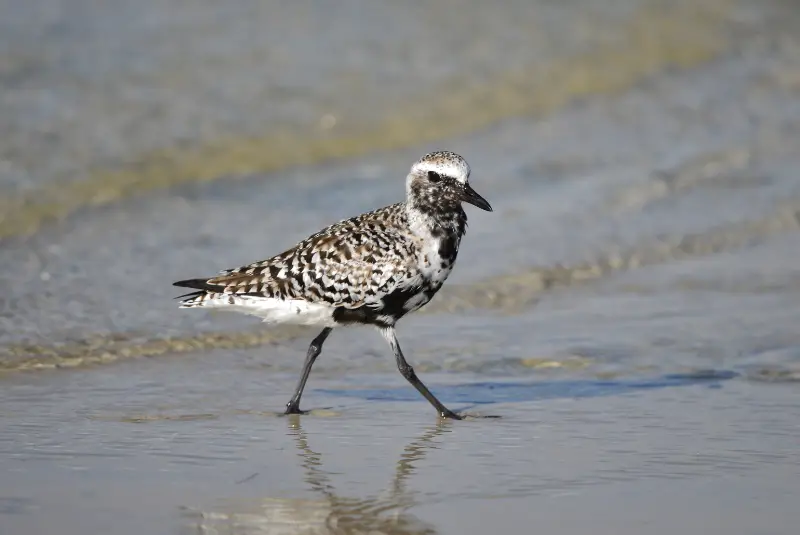
During the breeding season, the Black-bellied Plover is easy to identify by its striking black belly, breast, flanks, and face.
Outside of the breeding season, it is more drab, with white underparts and brown upperparts, and resembles a Sanderling in coloration.
However, it can be easily distinguished from a Sanderling by its much larger size.
This seabird is a winter visitor to Florida beaches, where it can be seen from late July until April.
Black-necked Stilt
Scientific name: Himantopus mexicanus

This wading bird is easy to identify by its striking black-and-white plumage coupled with long reddish pink legs.
With legs that are more than 9 inches long, the Black-necked Stilt has the longest legs of any bird in proportion to its body size.
This shorebird is a year-round resident in the state. Its preferred breeding habitat are shallow marshes, but during the winter it is also found along the coast.
Spotted Sandpiper
Scientific name: Actitis macularius
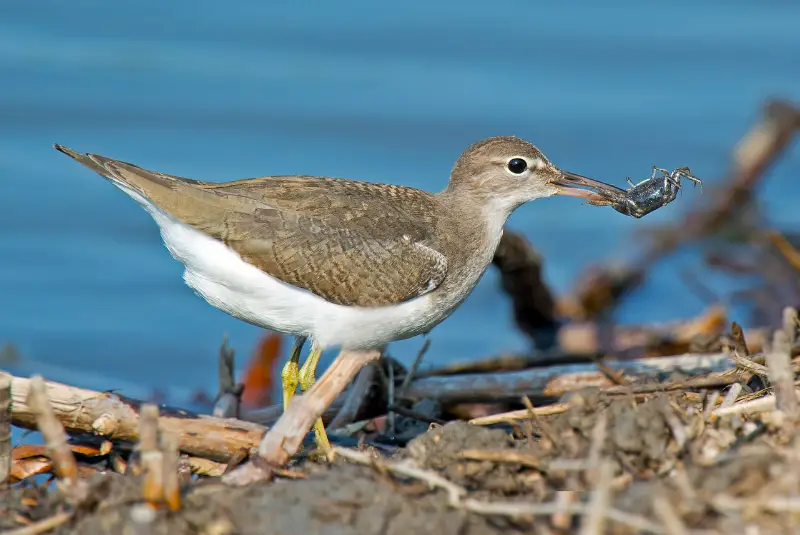
The Spotted Sandpiper is a common wintering bird in Florida, where it can be found on the edges of creeks and estuaries, as well as in freshwater habitats.
During the winter this water bird has a brownish gray upperside, which contrasts with its bright white underside. A great way to identify it is by its constant bobbing of the tail.
This Florida sandpiper forages on banksides and muddy areas, where it picks up small insects and invertebrates from the ground.
Willet
Scientific name: Tringa semipalmata
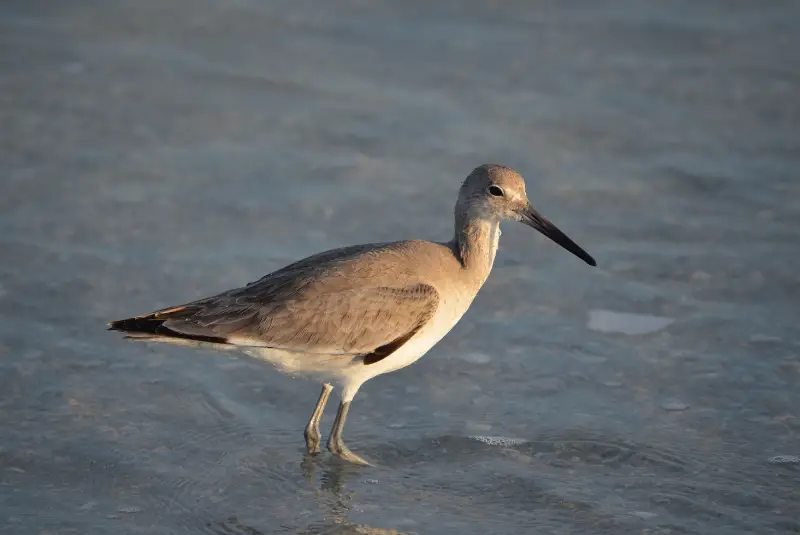
The Willet is common along the coast of Florida during the winter, but is also a year-round breeding bird in northern areas of the state.
It is a medium sized wading bird with a brown upper side and a white underside. It is a beach bird that only occurs in saltwater habitats.
When it takes to the wing, its conspicuous black-and-white wing markings become visible. It forages for small insects, worms, crabs, and other invertebrates along the ocean shore.
American Oystercatcher
Scientific name: Haematopus palliatus
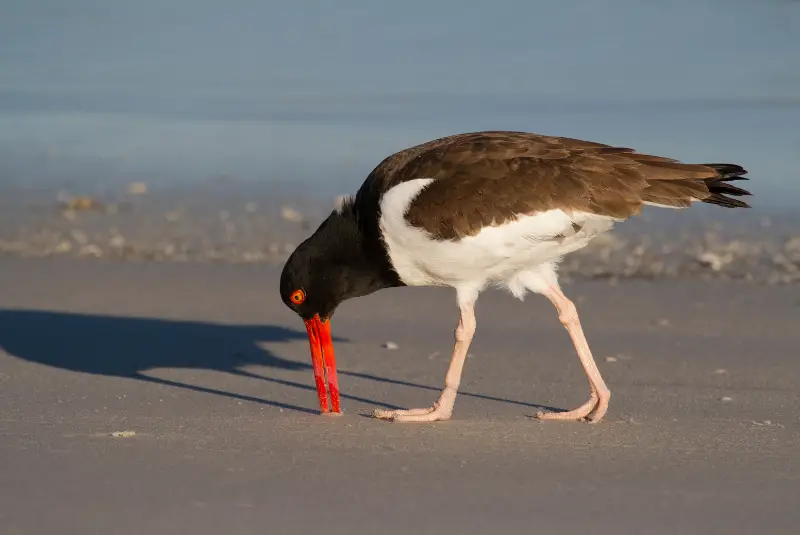
American Oystercatchers are beautiful beach birds with striking coloration. They have a jet black head and neck, which contrasts with a bright white belly and a long, heavy red bill.
The Oystercatcher is a bird of the tidal flats, where it follows the tidal patterns to feed on shellfish during low tide.
The heavy bill of the Oystercatcher helps it to pry open the shells of mollusks, and it also serves for hammering their shell until it shatters.
It is a year-round resident along the entire coast, inhabiting the tidal flats and beaches of Florida.
Great Egret
Scientific name: Ardea alba
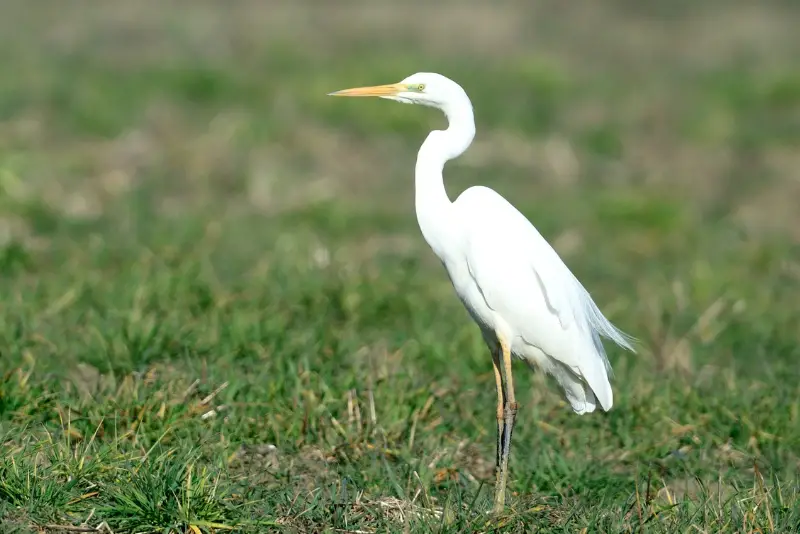
The Great Egret has a range that spans nearly the whole planet, and can be found on almost all continents.
This heron is a big bird that is all white, and it has long black legs and feet along with a thick, yellow bill.
During the spring and summer breeding seasons, the Great Egret grows a plume on its back that extends all the way to the tip of its tail.
It lives in both saltwater and freshwater habitats, and often nests in large colonies on the banks of marshes, lakes, and rivers.
Great Egrets forage in any type of shallow water, including ponds, lakes, rivers, estuaries, as well as rice fields and other flooded areas.
It is especially prevalent in the eastern and central regions of the state throughout the summer.
Outside of the breeding season it is less common, but where it occurs it can be seen in large flocks.
Snowy Egret
Scientific name: Egretta thula
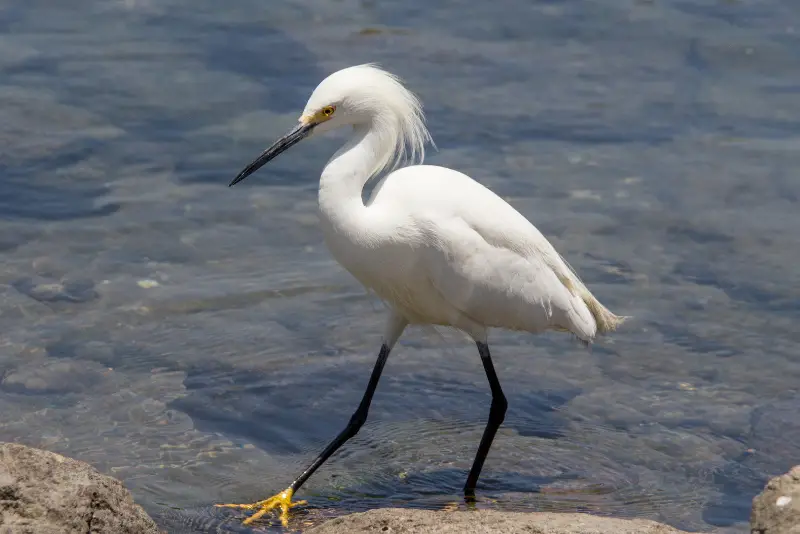
The Snowy Egret has become an increasingly common breeding bird all over Florida.
This is due to aggressive conservation efforts that were necessary because this Egret species was systematically hunted in previous centuries.
This little white heron stands out due to its slim black bill and bright area between the eyes and nostrils. These Florida birds have long legs and yellow feet, which distinguish it from other herons.
In adult birds, the feet are a brilliant golden yellow, while the legs are totally black. It is thought that the brightly colored feet help to attract small fish and other prey.
The legs of juvenile birds have a predominant greenish yellow color, with some black areas on the front of the leg.
It is found in practically all types of wetland environments, from small ponds to saltwater and everything in between.
During the summer, the Snowy Egret is a rare to relatively common breeding bird in the state.
It is much more common during the winter months, when large numbers can be observed in the coastal areas of Florida.
Little Blue Heron
Scientific name: Egretta caerulea

While adult Little Blue Herons are slate blue, young birds are entirely white during their first year.
Juvenile birds can be distinguished from other white herons by their dark bill and green legs.
These small herons are common breeding birds of Florida that can be seen year-round.
During winter, their numbers swell, due to an influx of birds from further north, which spend the winter months in Florida.
These birds feed on small fish, mollusks and crustaceans, with crayfish forming a large part of their diet.
They prefer an aquatic habitat, where these birds hunt in the shallows, and are rarely seen away from water.
Great Blue Heron
Scientific name: Ardea herodias
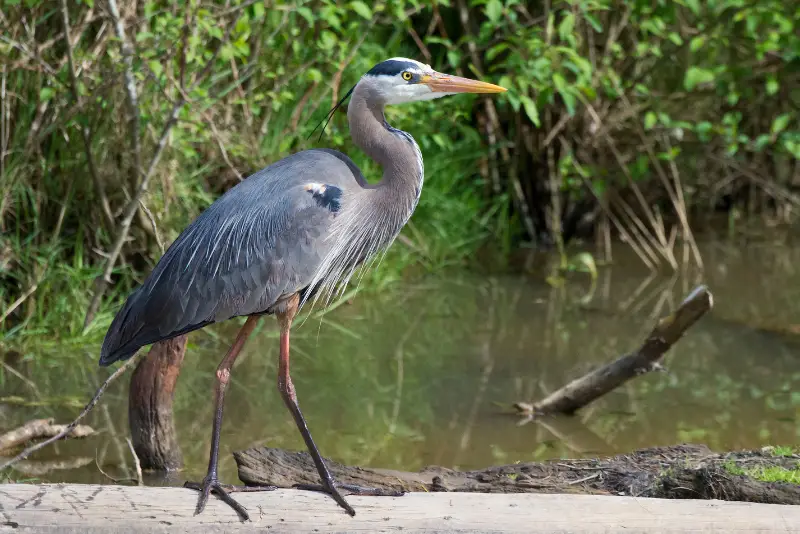
The Great Blue Heron is one of the most common herons in Florida, where it can be seen year round.
This heron is a very large bird with a wingspan of up to 6 feet. It is almost entirely blue gray, except for a white throat and eye stripe, as well as dark gray wing feathers.
This large heron likes to hunt for small fish by wading in the shallows of estuaries, mud flats and marshes along the seaboard.
It waits patiently for a suitably sized fish to come close enough to be grabbed with its long, yellow bill.
The Great White Heron is an all-white seabird that breeds in Florida Bay, and until recently it was thought that it is a subspecies of the Great Blue Heron.
However, recent evidence suggests that the Great White Heron is actually a different species.
White Ibis
Scientific name: Eudocimus albus
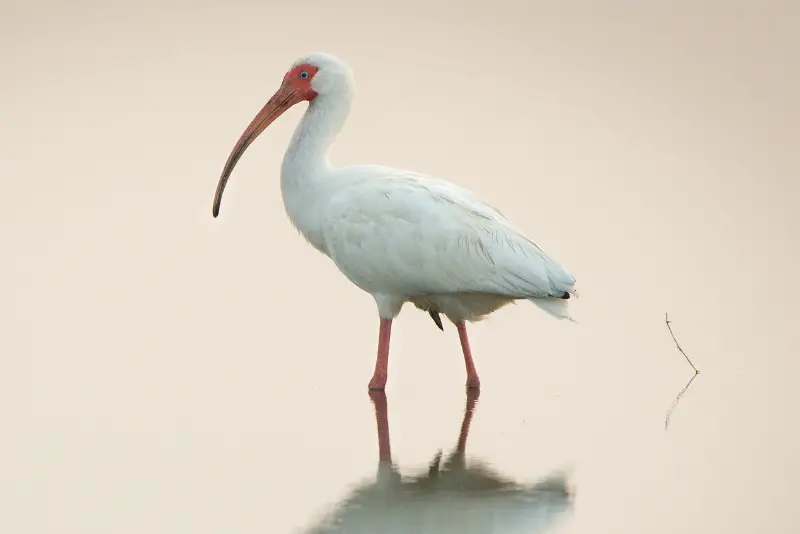
This species is easy to recognize due to its entirely white plumage and long orange beak that is curved downwards.
The black wing tips are not really apparent until it takes to the wing.
During the first two years of their lives, immature White Ibises have a chocolate brown body with light streaks and a pale orange beak.
While it is most commonly found in coastal areas, the White Ibis prefers to forage in freshwater habitats.
This shore bird feeds on fish, insects, crayfish, and other crustaceans. Crayfish form a large part of its diet in areas where they are common.
They nest in large colonies in forests located close to wetlands. These birds are extremely social, and like to forage in groups of 20 birds or more. In fact, it’s rare to see a solitary White Ibis.
Laughing Gull
Scientific name: Leucophaeus atricilla
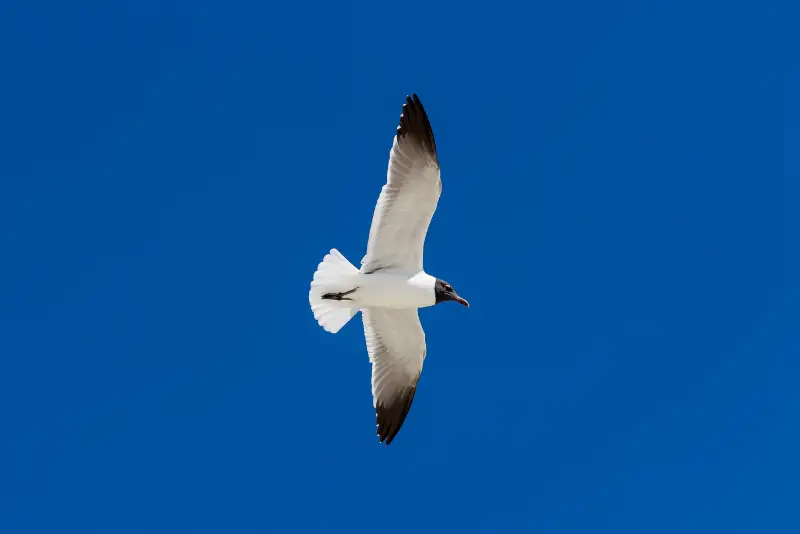
The Laughing Gull is common along the entire coast of the sunshine state, and can be easily identified by its black head and its loud call that resembles human laughter.
Adult Laughing Gulls in summer are largely white, with a black head and gray upperside. Both the bill and the legs are dark red. In contrast to adults, juvenile birds are pale gray brown.
Laughing Gulls are most common close to mud flats and sandy beaches, but these birds also occur away from land, foraging over open water.
These common seagulls are white birds that live in Florida year-round.
Outside of the breeding season, Laughing Gulls are sometimes also observed further inland on rare occasions, showing up at lakes and reservoirs.
Ring-billed Gull
Scientific name: Larus delawarensis
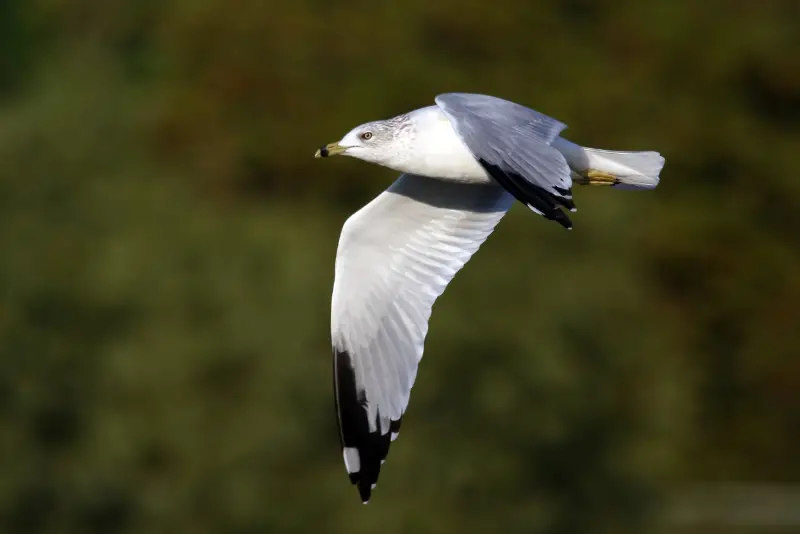
The Ring-billed gull is a common winter visitor throughout Florida. While it doesn’t nest in the state, a few birds can be seen during summer as well.
Adults are almost entirely white, except for their light gray upperparts and black wing tip, and bright yellow bill. Juvenile birds are more mottled in appearance, with a mix of brown and gray.
This seabird can be confused with the Herring Gull, but the latter is relatively rare in the state, while the Ring-billed Gull is common on large lakes and reservoirs.
The preferred habitat of this gull is close to inland bodies of water, although it also forages on parks, landfills, and golf courses. It is the most common seagull species seen at large reservoirs.
These seagulls are common birds of Florida during the winter, and start arriving in September, and most of them leave by March.
As a scavenger, it likes to frequent garbage dumps, where flocks with hundreds of birds can be seen at times.
Forster’s Tern
Scientific name: Sterna forsteri

The Forster’s Tern is a medium sized seabird that is a common breeding bird along the coast of Florida.
Adults are almost entirely white birds, except for their gray mantle and black cap. Their orange beak has a black tip.
In its non-breeding plumage, it loses most of its black cap, but can be identified by a characteristic comma shaped black eye patch.
The main breeding habitat of this tern are shallow seaside waters, including bays, inlets, and tidal flats.
In addition, Forster’s Tern may be encountered breeding in a range of freshwater settings, most frequently at lakes and reservoirs.
Outside of the breeding season, Forster’s Terns are rare winter visitors at reservoirs all over the state.
Caspian Tern
Scientific name: Hydroprogne caspia
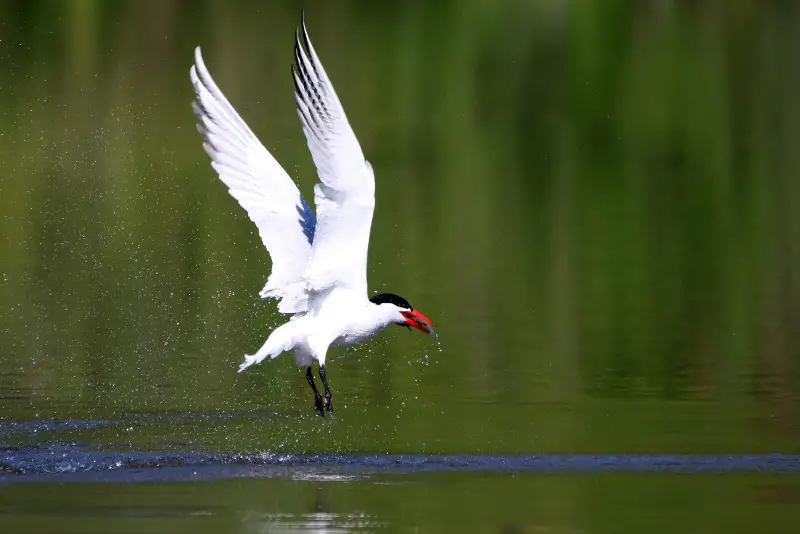
The Caspian tern is the largest tern species in the world, and a rare winter visitor in Florida.
It superficially resembles the Forster’s Tern, but it is a much larger bird and has a thicker bill, broader wings, and a less forked tail.
Also, during winter the Caspian Tern doesn’t lose its black cap completely, but always retains a streaked, dark crown.
Forster’s Terns, on the other hand, lose their cap entirely during winter, which becomes completely white.
The Caspian Tern is not only a skilled hunter, but this bird also steals food from other terns and gulls. It catches fish by diving into the water with astonishing precision.
The Caspian Tern breeds in freshwater habitats in Canada and northern USA, and winters in the Caribbean and the Gulf of Mexico.
Roseate Spoonbill
Scientific name: Platalea Ajaja
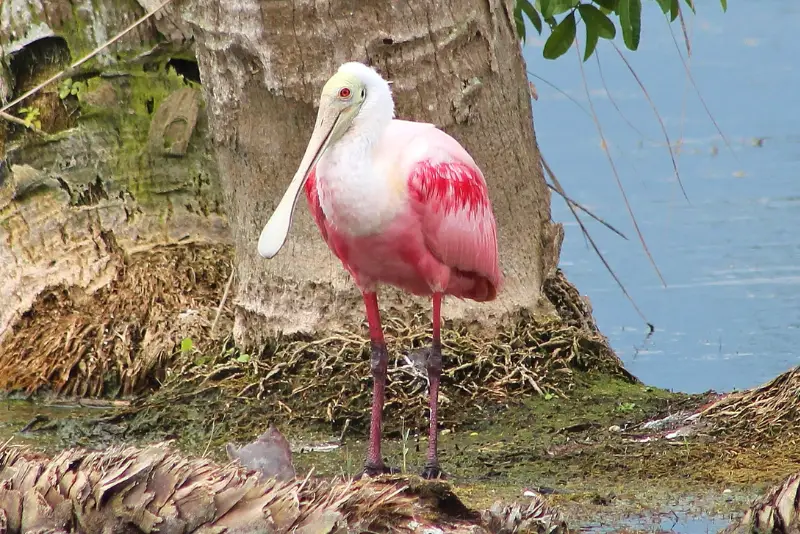
Roseate spoonbills are medium-sized wading birds, similar to storks but smaller.
The adults are white on their backs, neck, and face, while the rest of their plumage is bright pink. The Roseate Spoonbill is the most common pink bird in Florida.
However, it should be noted that the exact shade of pink can vary a lot, depending on its diet.
The more shrimp it eats, the more pink its plumage becomes, due to the carotenoid substances found in shrimp.
These birds are sometimes mistaken for flamingos because they look similar, but keen ornithologists will notice that flamingos have a short, angled bill, while spoonbills have a long, spatulate bill that has a broad “spoon” at its end.
The best place to see these gorgeous birds in the sunshine state is in the Everglades, which has more than 200 breeding pairs.
American Flamingo
Scientific name: Phoenicopterus ruber
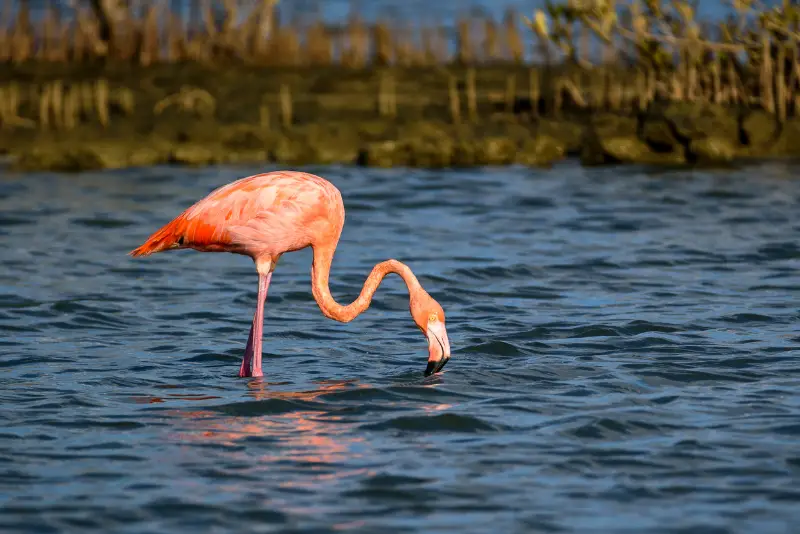
This Florida shore bird is a member of the flamingo family, Phoenicopteridae, that is found in North and South America.
When it comes to the sunshine state, no bird species is more synonymous with the culture of the state than the flamingo, which is somewhat ironic, given that it is not native to Florida.
Somewhat stereotypically associated with Miami, the American Flamingo is found along the coasts of the Caribbean, the Gulf of Mexico, as well as northern parts of South America.
It is thought that the population of American Flamingos is descended from birds that escaped from parks and zoos. It is most often seen in the Everglades and other areas with salt flats.
Double-crested Cormorant
Scientific name: Phalacrocorax auritus

The Double-crested Cormorant is a large, dark waterbird with a long neck and blue eyes. It is a year-round resident in Florida, and is commonly found on coastal waters.
This cormorant likes to gather in large flocks that roost on trees close to water. It is a skilled diver and hunts fish with its large, hooked bill.
When a group of cormorants flies together, they like to form up in a V shaped formation.
Often these V-shaped formations can be seen in the evening, when the birds fly to their roosting spots.
Royal Tern
Scientific name: Sterna maxima
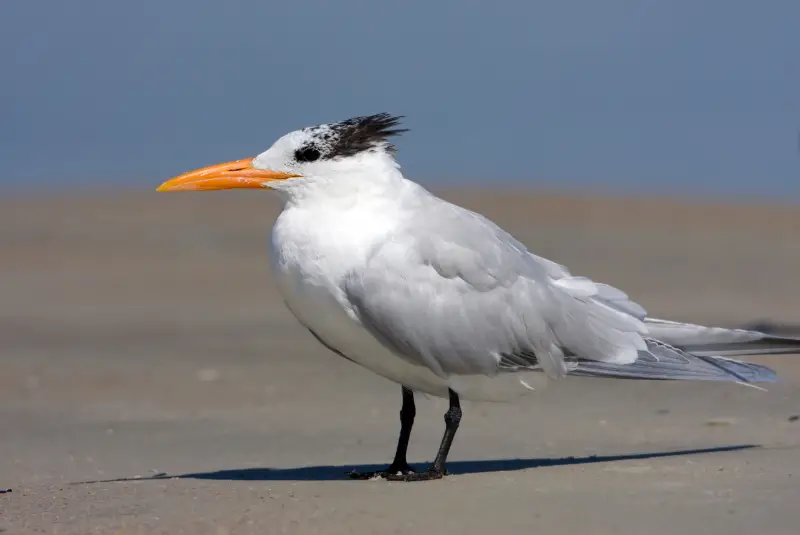
The Royal Tern is a breeding bird in southern Florida, where it can be found in Tampa Bay and Banana River.
During the winter, the Royal Tern population swells due to an influx of migratory birds that fly here from the north.
During the cold months, these beautiful birds can be seen along the entire coast of Florida. They hunt small fish by plunging head-first into the water.
Herring Gull
Scientific name: Larus argentatus
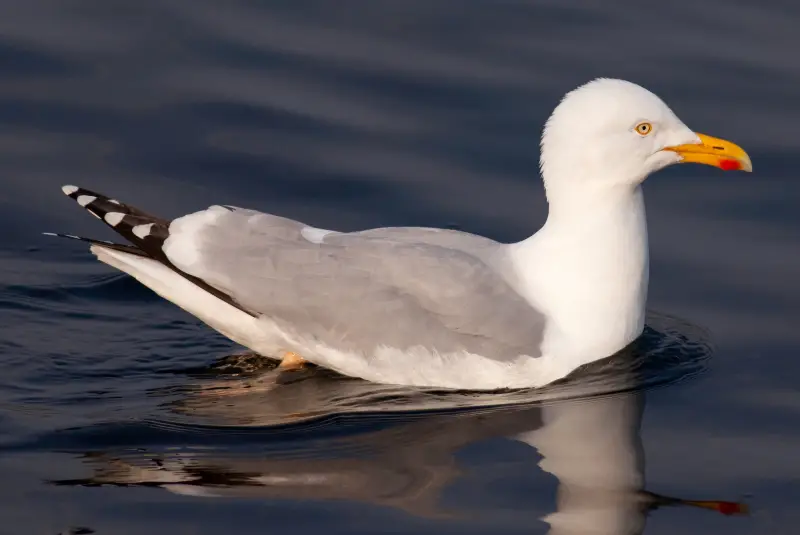
The Herring Gull is a common winter visitor along the entire Florida coastline. It is a scavenger, and likes to frequent landfills and garbage dumps.
This is a large gull with a white head and underparts, as well as a pale gray mantle and black wing tips. During the winter it has gray speckles on its neck and head.
Apart from scavenging, it also feeds on fish, mollusks, and crustaceans.
It is a very intelligent bird, and likes to drop shellfish from a great height in order to crack their shell open and feed on the soft interior.
Tricolored Heron
Scientific name: Egretta tricolor
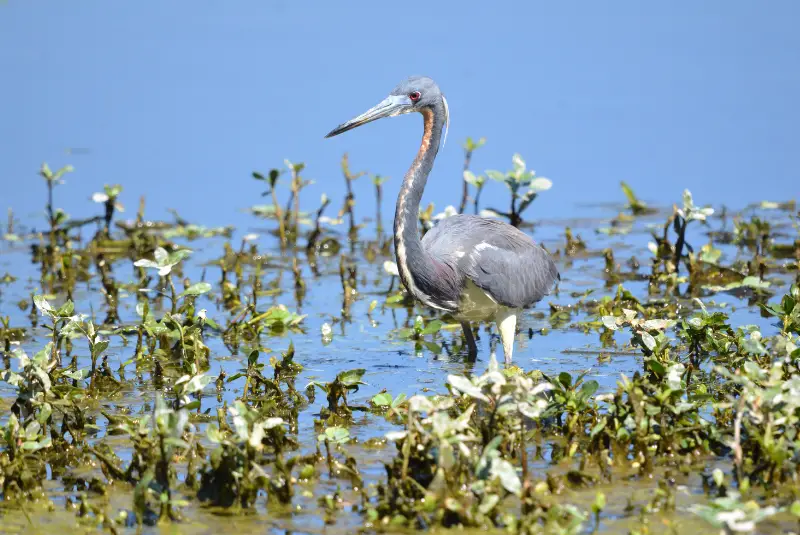
The Tricolored Heron is a medium-sized heron that has a blue-gray upper side and chest, as well as a white belly.
It is a breeding bird in the state, where it is most often found in estuaries and salt water marshes. It likes to nest in colonies, and sometimes forms colonies with other heron species.
This shorebird hunts fish and invertebrates in shallow waters, usually by patiently waiting until its prey comes within reach.
Black Skimmer
Scientific name: Rynchops niger
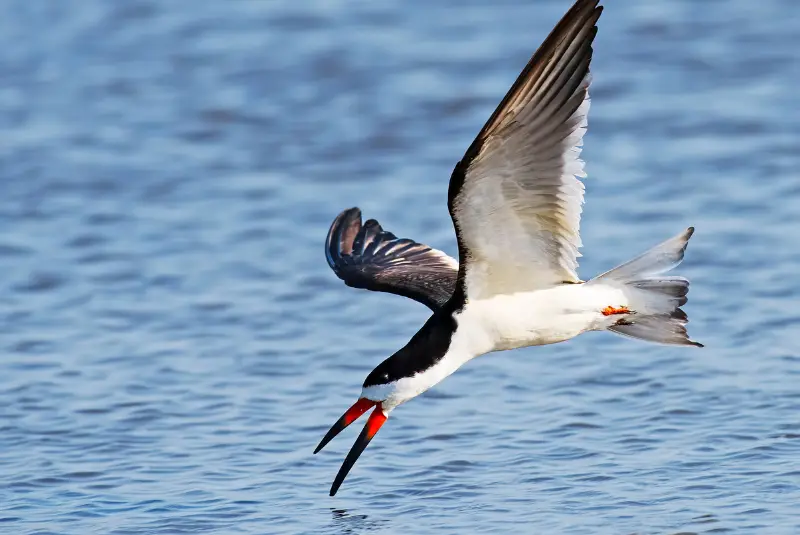
The Black Skimmer is a striking shore bird that is easy to identify both by its appearance and its behavior.
The black upperside contrasts with a bright white underside, and with a long, bright red bill. The lower part of the bill is significantly longer than the upper part.
It catches fish by flying along the water surface, while pulling its lower bill through the water. When the lower bill encounters a fish, the bill slams shut to catch its prey.
The Black Skimmer breeds along the Gulf Coast and the Florida East Coast, and also occurs as a winter visitor in more southern areas.
Brown Pelican
Scientific name: Pelecanus occidentalis

The Brown Pelican is a common sight along the Florida seashore, where it hunts fish by plunging head-first into the water.
Adult Brown Pelicans are grayish brown with a dark belly, and can be easily recognized by their massive bill.
While this pelican species was endangered a few decades ago due to pesticide poisoning, it has now recovered and is once more a common breeding bird and year-round resident in the state.
What are the most common Florida beach birds?
The most common Florida beach birds are Sanderlings, which can be seen running along the beach at the edge of breaking waves.
They are small wading birds that are largely white and light brown, which makes them easy to distinguish from other birds.
What are the black birds on Florida beaches?
The black birds that can be seen on Florida beaches are American Oystercatchers. They have a black head, neck and back, which contrasts with their bright white underside. Another feature that helps to identify them is their thick orange bill.
